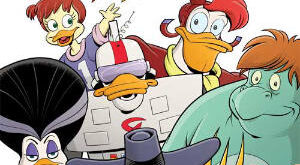From Walt Disney Pictures comes “TRON: Legacy,” a high-tech adventure set in a digital world that is unlike anything ever captured on the big screen. Directed by Joseph Kosinski, “TRON: Legacy” stars Jeff Bridges, Garrett Hedlund, Olivia Wilde, Bruce Boxleitner, James Frain, Beau Garrett and Michael Sheen and is produced by Sean Bailey, Jeffrey Silver and Steven Lisberger, with Donald Kushner serving as executive producer, and Justin Springer and Steve Gaub co-producing. The “TRON: Legacy” screenplay was written by Edward Kitsis and Adam Horowitz; story by Edward Kitsis & Adam Horowitz and Brian Klugman & Lee Sternthal; based on characters created by Steven Lisberger and Bonnie MacBird.
Presented in Disney Digital 3D, Real D 3D and IMAX 3D and scored by Grammy Award–winning electronic music duo Daft Punk, “TRON: Legacy” features cutting-edge, state-of-the-art technology, effects and set design that bring to life an epic adventure coursing across a digital grid that is as fascinating and wondrous as it is beyond imagination.
At the epicenter of the adventure is a father-son story that resonates as much on the Grid as it does in the real world: Sam Flynn (Garrett Hedlund), a rebellious 27-year-old, is haunted by the mysterious disappearance of his father, Kevin Flynn (Oscar and Golden Globe winner Jeff Bridges), a man once known as the world’s leading tech visionary.
When Sam investigates a strange signal sent from the old Flynn’s Arcade—a signal that could only come from his father—he finds himself pulled into a digital grid where Kevin has been trapped for 20 years. With the help of the fearless warrior Quorra (Olivia Wilde), father and son embark on a life-or-death journey across a visually stunning digital landscape created by Kevin himself that has become far more advanced, with never-before-imagined vehicles, weapons, landscapes and a ruthless villain who will stop at nothing to prevent their escape.
THE VISIONARIES
First released in 1982, the original “TRON” was Walt Disney Studios’ groundbreaking high-tech film from visionary writer/director Steven Lisberger, who went on to become a producer on “TRON: Legacy.” “TRON” pioneered the use of computer graphics, virtual sets and backlit effects. Its unique blend of 70mm live action, CG, and hand-drawn animation was a major motion-picture studio first. As a result, “TRON” became a cult classic that has remained firmly in the currents of popular culture for more than 25 years and is now cherished as a defining moment for effects movies.
Today’s exciting technological advances led to some exhilarating possibilities in visualizing a “TRON” stand-alone follow-up film that would play to present-day audiences. With Generation XBOX hooked into the Internet, phones that are tiny computers and everyone playing games wirelessly, the world we live in was only dreamt of when “TRON” was made.
Steven Lisberger was instrumental in trying to get “TRON: Legacy” off the ground. “We started discussions at Disney about ten years ago…I’ve seen numerous Disney executives go from black hair to grey in those years, and the film itself has changed over the years and gone through many different phases. When it emerged more recently, I think there was a sense that the right group of people somehow had now all arrived at the right spots. We explored some roads before this, but after a while we realized they really didn’t resonate with the times. But this storyline did.”
Producer Sean Bailey, who was then president of Idealogy, Inc., takes up the story, revealing that he and his team were brought on board to speed up development around four years ago. “Disney had played around with a couple of drafts written in the ’90s and couldn’t find something they were satisfied with, so they brought us on to see what we could do. We were honestly just developing, coming up with ideas and meeting with writers.”
“‘TRON: LEGACY’ is technically a stand-alone film, so you can come to this movie clean and enjoy it, and the story will hold up for what it is.” —Sean Bailey, producer
As the movie was bubbling along in early development, a lucky break saw co-producer Justin Springer discovering director Joseph Kosinski’s test reel almost by accident. Despite Kosinski’s lack of movie experience, his talent was clearly proven in his unique visionary approach as a commercial director on campaigns such as “Halo,” “Gears of War” and Nike.
Armed with a degree in architecture from Columbia University, Kosinski has a flair for design and aesthetics as well as a comfort level with digital technology that comes through in his work. “The whole way we make movies is changing, and I’m convinced Joe [Kosinski] is one of the leaders of that revolution,” says Bailey.
Sean Bailey recalls the early days with first-time director Joseph Kosinski. “I met Joe and was immediately struck by his vision, his story sense and his confidence. We then went into the studio and talked about how we wanted to advance the process. The confidence Joe inspired is what got us to that first VFX test.”
Kosinski, Bailey and the rest of the team convinced the Disney executives to authorize a proof-of-concept test, which was a short film showing what today’s technology could do with the iconic elements of the “TRON” digital world, such as Lightcycles and disc battles. The result was an amazing piece of footage that wowed the crowd at the 2008 San Diego Comic Con and the filmmakers got approval to start work on the film itself.
The electronically produced music also was re-imagined, thanks to Daft Punk, the visionary pioneers of the art form. From their first single release in 1993, the combined talents of DJs Guy-Manuel de Homem-Christo and Thomas Bangalter were hailed as a new breed of house innovators. Daft Punk’s sound is a brazen, dance floor-oriented blend of progressive house, funk, electro and techno. Following their brilliant debut in 1997 (Homework), the duo went on to release two more studio albums (Discovery—2001, Human after All—2005) and two live albums (Alive 1997, Alive 2007).
When Joseph Kosinski came on board to helm “TRON: Legacy,” he heard that Daft Punk, whose art form and style were influenced by the original “TRON,” were interested in the project. A pancake breakfast in Hollywood soon followed, where the three talked about Kosinski’s vision for the film.
The three artists found themselves on the same creative page and began working on the score very early on in the filmmaking process. The score took shape over the course of three years and is a unique combination of orchestra, electronic and granular sounds.
The duo worked closely with the filmmakers not only on the score, but on the sound design too, especially the moments where sound design and room tones bleed into cues. It was a very sophisticated musical approach—a layering blend that occasionally blurs the line between music and sound design in a very interesting way. “We’ve got over 100 minutes of music in this movie. And it’s so tied to the visuals because we had it so early, I just can’t imagine this film without it,” says Kosinski.
All the newest technology gives “TRON: Legacy” its cutting-edge look and feel, since the filmmakers had far fewer limitations for what computers can achieve. But even with the obvious visual advantages, the filmmakers have striven to keep the spirit of Lisberger’s dream intact.
To pull that off, the movie gathers together some of the most sophisticated filmmaking technology available today, including even more advanced cameras than those used on “Avatar,” a blend of computer graphics and practical sets.
With that technology put in the hands of talented, creative designers and visionary filmmakers, above and below the line, “TRON: Legacy” showcases cutting-edge design and astounding visual effects enhanced by the latest stereoscopic (3D) technology. The film blends live action and photorealistic computer animation in ways only dreamed of in the past. As producer Jeffrey Silver says, “It seemed obvious that ‘TRON,’ being the groundbreaking film that it was in the ’80s, had to be followed with a film equally as groundbreaking in the 21st century. If we were going to do ‘TRON: Legacy’ right, we would have to push the envelope. And we did.”
THE EVOLUTION OF THE STORY
In 1982, when Kevin Flynn (Jeff Bridges) made it out of the Grid alive and back in control of Encom, the company he founded with his longtime friend and associate, Alan Bradley (Bruce Boxleitner), everyone assumed Kevin would be content with developing and producing popular games.
On the surface of things, that appeared so: Kevin married, had a son, Sam, and settled into fatherhood while he and Alan grew Encom into a video game powerhouse. But unbeknownst to outsiders, Kevin was still experimenting with teleportation, making frequent visits back to the Grid from the privacy of his secret lab hidden beneath Flynn’s Arcade. Then one day Kevin simply vanished, and Sam was left alone with no father and no answers.
And twenty years later, “TRON: Legacy” begins.
When a pager signal draws the now-adult Sam (Garrett Hedlund) to Flynn’s Arcade and he is transported to the Grid where his father has been trapped for 20 years, he begins a journey that will change his life—and the life of his long-absent father.
“From the very beginning, Sean [Bailey] and I told the studio that this movie was going to be a father-son story. And that’s really what the heart of ’TRON: Legacy’ is.” —Joseph Kosinski, director
“It was very important to us, amidst all this visual spectacle, to focus on a father/son story; this is about a boy who’s lost his dad, who’s now grown up and, as a man, he has scarring from that. Then, he learns that his father’s disappearance may not have been all that he thought, and there’s a chance for them to rebuild their relationship,” says producer Sean Bailey. “Our goal is to make sure we’re serving our story the best way we can. And the visuals, the effects, the music, the performances and the style all support that,” he adds.
The estrangement and rediscovery between father and son is the story’s emotional entry point. “You’re coming into this spectacular domain and you need someone to experience it through. That’s how we approached developing Sam’s character. You’re discovering the Grid through Sam’s eyes, and you’ll also discover Flynn through Sam,” says Adam Horowitz, who co-wrote the screenplay with Edward Kitsis (story by Edward Kitsis & Adam Horowitz and Brian Klugman & Lee Sternthal, based on characters by Steven Lisberger and Bonnie MacBird).
Steven Lisberger feels that it is important to have a story that is as significant as all the technical aspects that go into the film. “I care about story and characters as much as I do the visuals. The story aspect of Flynn still being alive and the father-son story is really compelling in ‘TRON: Legacy.’ It will resonate with the fan base, but if someone hasn’t seen the first film, it doesn’t matte —the story will work for him or her too,” he says.
Jeff Bridges, who reprises his role of Kevin Flynn from the original “TRON,” comments, “One of the underlying elements of the story is technology. It’s so exciting to realize all the things that you can do. But what’s happening with technology is that it is developing so fast that we haven’t really developed any ethics to go along with it, or knowledge of what some of the ramifications of this technology will be. So that’s also a theme that ‘TRON: Legacy’ deals with.”
 Premier Pop C Pop Culture News – Movies, Comics, Television, Books, Toys, Games, and More
Premier Pop C Pop Culture News – Movies, Comics, Television, Books, Toys, Games, and More 


